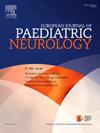Pediatric acute-onset neuropsychiatric syndrome: A single-center retrospective study
IF 2.3
3区 医学
Q3 CLINICAL NEUROLOGY
引用次数: 0
Abstract
Aim
To facilitate the diagnosis of Pediatric Acute-Onset Neuropsychiatric Syndrome (PANS) in children, we described the clinical features of a PANS cohort and analyzed whether immunotherapy could shorten the symptom duration.
Methods
We retrospectively analyzed the medical records of children with PANS at the Children's Hospital of Chongqing Medical University and categorized them into two groups on the basis of whether they received immunotherapy to compare symptom duration.
Results
Forty-two patients were included. Thirty-three children (76.2 %) had infection within 4 weeks before onset. Thirty-six (88.1 %) children had obsessive‒compulsive symptoms, 5 children (11.9 %) had eating disorders, and one child had both. Other common clinical manifestations included sleep disturbances (76.2 %, 32/42), academic difficulties (73.8 %, 31/42), irritability (66.7 %, 28/42), developmental regression (54.8 %, 23/42), motor abnormalities (52.4 %, 22/42), hallucinations (52.4 %, 22/42), anxiety (50 %, 21/42), aggression (40.5 %, 17/42), hyperesthesia (31.0 %, 13/42), and emotional lability (23.8 %, 10/42). One child had epileptiform discharges on the electroencephalogram (EEG), while the other 41 children had normal EEGs. Brain magnetic resonance imaging (MRI) and cerebrospinal fluid (CSF) analysis were normal in all the children. Immunotherapy was used in 12 patients, and there was not a significant difference in symptom duration between the two groups (immunotherapy group: median 17, IQR 14–21; nonimmunotherapy group: median 15, IQR 11–20; p = 0.275).
Conclusions
PANS is usually triggered by infection and is accompanied by a variety of neuropsychiatric symptoms. In our retrospective small-sample study, immunotherapy did not shorten the duration of symptoms in children with PANS. However, further prospective studies are still needed to confirm its effectiveness.
儿童急性发作神经精神综合征:一项单中心回顾性研究
目的:为了方便儿童急性发作性神经精神综合征(PANS)的诊断,我们描述了一个PANS队列的临床特征,并分析了免疫治疗是否可以缩短症状持续时间。方法回顾性分析重庆医科大学附属儿童医院pan患儿的病历,根据是否接受免疫治疗将患儿分为两组,比较症状持续时间。结果纳入42例患者。发病前4周内感染33例(76.2%)。36名儿童(88.1%)有强迫症状,5名儿童(11.9%)有饮食失调,1名儿童两者兼有。其他常见临床表现包括睡眠障碍(76.2%,32/42)、学习困难(73.8%,31/42)、易怒(66.7%,28/42)、发育倒退(54.8%,23/42)、运动异常(52.4%,22/42)、幻觉(52.4%,22/42)、焦虑(50%,21/42)、攻击性(40.5%,17/42)、感觉亢进(31.0%,13/42)和情绪不稳定(23.8%,10/42)。1例患儿脑电图显示癫痫样放电,其余41例患儿脑电图正常。脑磁共振成像(MRI)和脑脊液(CSF)分析均正常。12例患者接受免疫治疗,两组患者的症状持续时间无显著差异(免疫治疗组:中位数17,IQR 14-21;非免疫治疗组:中位数15,IQR 11-20;p = 0.275)。结论span多由感染引发,并伴有多种神经精神症状。在我们的回顾性小样本研究中,免疫治疗并没有缩短pan患儿的症状持续时间。但仍需进一步的前瞻性研究来证实其有效性。
本文章由计算机程序翻译,如有差异,请以英文原文为准。
求助全文
约1分钟内获得全文
求助全文
来源期刊
CiteScore
6.30
自引率
3.20%
发文量
115
审稿时长
81 days
期刊介绍:
The European Journal of Paediatric Neurology is the Official Journal of the European Paediatric Neurology Society, successor to the long-established European Federation of Child Neurology Societies.
Under the guidance of a prestigious International editorial board, this multi-disciplinary journal publishes exciting clinical and experimental research in this rapidly expanding field. High quality papers written by leading experts encompass all the major diseases including epilepsy, movement disorders, neuromuscular disorders, neurodegenerative disorders and intellectual disability.
Other exciting highlights include articles on brain imaging and neonatal neurology, and the publication of regularly updated tables relating to the main groups of disorders.

 求助内容:
求助内容: 应助结果提醒方式:
应助结果提醒方式:


